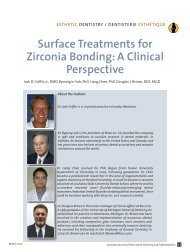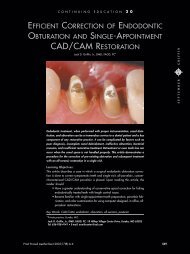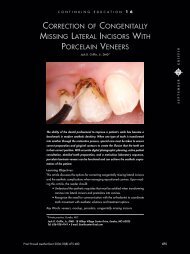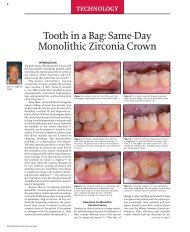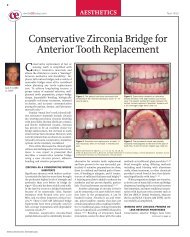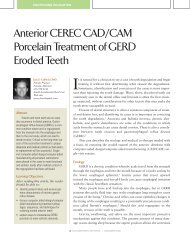C - Eureka Smile Center
C - Eureka Smile Center
C - Eureka Smile Center
You also want an ePaper? Increase the reach of your titles
YUMPU automatically turns print PDFs into web optimized ePapers that Google loves.
technique_ giomers I<br />
Fig. 7 Fig. 8 Fig. 9<br />
Fig. 10 Fig. 11 Fig. 1<br />
Will these flowable materials replace each of the<br />
more viscous composite materials No. The sculptability<br />
and layering potential of conventional composites<br />
will always have a place in esthetic dentistry.<br />
Another advantage of a non-flowable material is void<br />
reduction in posterior composites as uncured flowable<br />
is followed by a more viscous material pushing<br />
out and displacing the flowable as the viscous compule<br />
material is injected.<br />
_Patient exam and planning<br />
A 15-year-old male came to the office with an<br />
“unpleasant” smile after having orthodontic treatment<br />
the previous year (Fig. 1). His primary concern<br />
was the hypertrophic tissue around his incisors and<br />
his cold and sweet sensitivity (Fig. 2). There was rampant<br />
decay, enlarged gingival tissue, poor hygiene<br />
and decalcification areas (Figs. 3, 4).<br />
A full series of radiographs and photographic images<br />
were taken for treatment planning, marketing<br />
and case documentation. These images were studied,<br />
along with clinical exam notes, before treatment so<br />
that a basic plan was formulated. 14<br />
A treatment plan was made to do 23 direct composite<br />
restorations over three appointments after a<br />
prophy, oral hygiene education and tray-delivered<br />
home topical fluoride delivery. The plan included<br />
laser gingivoplasty followed by restorations with<br />
Beautifil II because of its esthetics, ease of use, fluoride<br />
release and versatility.<br />
After several weeks of maintained oral hygiene<br />
improvement, the surface of the anterior teeth would<br />
be re-contoured and enhanced at no additional<br />
charge.<br />
_Soft-tissue enhancement<br />
Lasers have become a critical component of smile<br />
rehabilitations, and if done with respect to periodontal<br />
tissues and biologic width, results can be a<br />
great enhancement to cosmetic treatment. 15,16 Diode<br />
lasers offer excellent control of tissue sculpting with<br />
very predictable healing and tissue tolerance as long<br />
as sound biologic principles are followed. 17–19 These<br />
principles must be understood during treatment in<br />
order to prevent possible chronic periodontal inflammation<br />
and unwanted gingival responses such as<br />
redness, bleeding and irritation. 20,21<br />
On the first restorative appointment, a local anesthetic<br />
(Septocaine, Septodont USA, Lancaster, Pa.)<br />
was given and retractors (See More, Discus, Culver<br />
City, Calif.) were placed to keep the lips out of the way<br />
and to provide some isolation from saliva. An 810 mm<br />
diode laser (Odyssey, Ivolcar Vivadent, Amherst, N.Y.)<br />
was used on a relatively low wattage, 2.0, to sculpt<br />
the tissues and remove hyperplastic gingival tissue<br />
(Fig. 5). 22<br />
Clean up and removal of the charred tissue was<br />
done with a microbrush and hydrogen peroxide. It is<br />
expected that the new soft-tissue location would be<br />
maintained or even improve with properly contoured<br />
restorations, good surface polish and continued<br />
plaque control. 23<br />
_Giomer composite technique: maxillary<br />
The goal of this one-hour restorative appointment<br />
was to provide improved esthetics and an<br />
environment to promote tissue recovery on the<br />
maxillary anterior. Tooth preparation was done with<br />
Fig. 7_Contour Matrices were placed<br />
and a BAC containing 37 percent<br />
phosphoric acid etch was placed and<br />
rinsed.<br />
Fig. 8_Several coats of a universal<br />
bonding agent were applied and air<br />
thinned.<br />
Fig. 9_Beautifil Flow Plus was<br />
applied to cover all dentin and then<br />
cured.<br />
Fig. 10_The Contour Matricies form<br />
a good gingival seal keeping the<br />
crevicular fluids out while giving<br />
anatomical form to the material.<br />
Fig. 11_The remaining cavities were<br />
restored with the same flowable<br />
material. Notice how the material<br />
holds its shape without running even<br />
before curing.<br />
Fig. 12_Light polymerization was<br />
done from facial, lingual and incisal<br />
to insure a high level of conversion.<br />
(Images/Provided by Dr. Jack D.<br />
Griffin, Jr.)<br />
cosmetic<br />
dentistry 1_2012<br />
I 33



